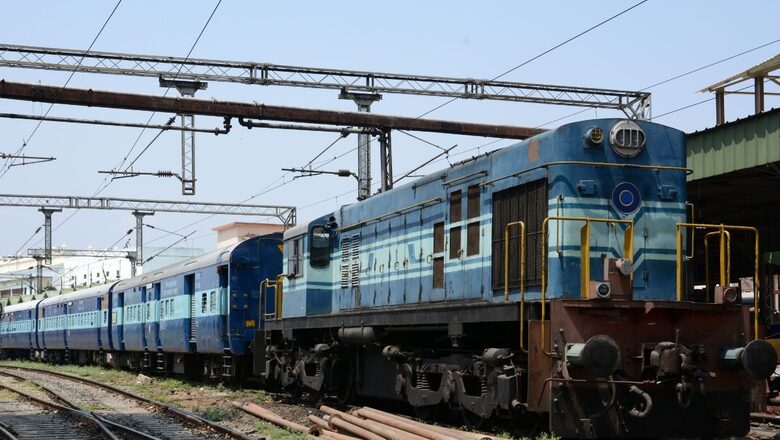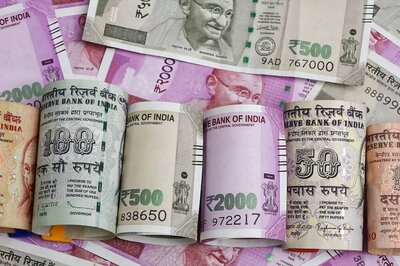
views
The Modi government has pursued the electrification of the railway network at a record speed. Railway Minister Ashwini Vaishnaw recently informed the Lok Sabha that as of June 30, 2023, a total of 59,096 route kilometres (RKM) on the Broad Gauge network has been electrified. Out of this, the lion’s share of 37,011 route kilometres (RKM) have been electrified during the last nine years (unstarred question no. 940 dtd July 26, 2023). The figures imply that close to 90 per cent of the Broad Gauge network has been electrified.
The network, in turn, constitutes 95 per cent of the entire railway network. This is indeed an exemplary achievement, surpassing those of all previous governments, despite Indian Railways battling the lowest manpower. The overall personnel strength has declined to 12.13 lakh by the end of FY 2021-22 as against 13.26 lakh by the end of FY 2014-15.
The imprint of complete electrification is evident in the composition of the locomotives. In FY 2020-21, the number of diesel locomotives was 5,108 and electric locomotives was 7,587, whereas, in FY 2021-22, the numbers changed to 4,747 and 8,429 respectively. There is a trend to retire diesel locomotives, which until a few years ago, were far more numerous than electric locomotives. The Indian Railways admitted to the economic non-viability of converting the diesel locomotives into electric locomotives (Fourteenth Report of the Standing Committee on Railways 2022-23, Demand for Grants 2023-24, P.40). Though the figures were not shared, dual-use engines are also being manufactured by the Railways. Diesel locomotives actually work by converting the oil into electricity, and not by combustion, unlike roadway vehicles. This makes the energy efficiency of diesel locomotives quite high.
The objective of electrification, according to Indian Railways, is to reduce the nation’s dependence on imported petroleum-based energy and enhance the energy security of the country, in addition to making the railway system eco-friendly and modern. In its press release dated September 12, 2018, the CCEA (Cabinet Committee on Economic Affairs) while approving the proposals for electrification of the remaining non-electrified portion of the railway network, covering 13,675 route kilometres (16,540 track kilometres), stated that the switchover would lead to saving of 2.83 billion litres of high-speed diesel oil per annum and reduction in environmental impact of Railways.
While electrification is likely to economise the Railways’ fuel bill to a great extent (Rs 13,510 crore saving as per 2018 figures), its other advantages require dispassionate examination. At present, nearly 74 per cent of the electricity in India is generated from fossil fuels like coal. In FY 2020-21, out of 1382 billion units appx generated in India, 1032 billion units was from fossil fuel source, and only 349 billion units appx were from non-fossil fuel source like hydro, air and solar power. Though the situation has slightly improved since 2005-06 when fossil fuel contributed 79 per cent of the energy basket, it is still high enough. (Ministry of Power Annual Report 2021-22, P.27). It is easy to notice the distortion that has crept in since the 1970s when the proportion of non-fossil to fossil fuel was quite healthy.
Thus, the Railways’ shift from diesel to coal is not likely to contribute to rectifying the environmental situation to a great extent. While the Indian Railways might show a favourable carbon balance situation, in reality, the coal burnt in thermal plants to supply electricity to the railway power grid will still leave a carbon imprint on nature. We would be burning the coal in thermal plants, unlike in the furnace of the locomotive once upon a time.
Electric traction was introduced in Indian Railways way back in 1925 when a segment of 16 km on the Central Railway from Bombay to Kurla was electrified on a 1500 Volt DC system to provide fast suburban service. Until the time of independence, merely 388 route kilometres had been electrified, out of almost 53,000 km route kilometres then in existence.
Until the mid-1980s, steam remained the predominant mode of traction in Indian Railways. During FY 1980-81, the Indian Railways had an aggregate of 10,908 locomotives, of which 7,469 were steam-powered; 2,403 were diesel-powered; and only 1,036 ran on electricity. This was because coal was in abundant supply in India, whereas, there was competing claim on electricity from different parts/sectors in the country. Rural electrification was thought more necessary from a sociological point of view than railway electrification. Electrification also requires high capital expenditure. Until 1986, when the Parliamentary Railway Convention Committee (1985) presented its fifth report on railway electrification, only 10.4 per cent of total route kilometres, which constituted 21.8 per cent of Broad Gauge route kilometres had been electrified. The report (1986) claims that it was only lately that a high priority was accorded to electrification.
A perusal of the locomotive composition in subsequent years bears out that diesel was in tough competition with electricity as a substitute for steam traction. By FY 2010-11, the number of steam engines had declined to a mere 43, whereas diesel engines numbering 5,137 were far ahead of electric engines numbering 4,033 (Indian Railways Year Book 2021-22, P.85).
In January 2015, the Railway Board set up an Environment Directorate to coordinate all environment management initiatives across the Indian Railways. The goal was to cut carbon emissions by 33 per cent by 2030. Though the Indian Railways has used a mix of renewable energy resources for its auxiliary energy needs like the use of lights and fans in offices, railway stations, and even inside the train, the real game is in traction which is still dependent on the main source of energy, predominantly coal.
Though the coal reserve is aplenty in India, it is concentrated in certain parts of the country. The coal reserves are mostly located in Odisha, Jharkhand, Chhattisgarh, West Bengal, Madhya Pradesh, Telangana and Maharashtra belt. Uttar Pradesh, for instance, has an installed thermal output capacity of 21417.26 MW, far greater than the 4989.85 MW of Odisha, though the former is nowhere in comparison to the latter as far as coal reserves are concerned, as a Ministry of Power publication shows (Growth of Electricity Sector in India 1947-2023, P.75 map). Similarly, Maharashtra’s installed capacity (thermal) is 28766 MW though coal reserves are not in proportion. It is easy to see that bigger thermal power plants are more likely to be located in larger states rather than coal-rich states. Thus, Karnataka’s thermal installed capacity is higher than that of West Bengal despite the fact the former has negligible coal reserves and the latter substantial.
This implies the coals have to be moved from collieries to thermal plant sites. This is done mostly by the Railways. During FY 2021-22, approx 66.20 per cent of coal produced or imported was moved by the Indian Railways (Indian Railways Year Book 2021-22, P.17). A total of 652.80 million tonnes of coal, inclusive of 271.12 million tonnes for thermal powerhouses, was carried by the Indian Railways during FY 2021-22 (ibid P.38). Coal formed 46.11 per cent of all freight moved by the Indian Railways in the corresponding period (ibid, P.39). The other main items moved by the Railways like food grains, iron and steel, iron ore, cement, fertilizers, stone, salt do not remotely come in any comparison with coal when it comes to bulk freight.
A hundred per cent railway electrification will mean the national carrier would lean further on coal for its energy requirements. This will involve increased carrying of coal from collieries to thermal power plants, thus burdening the railway tracks all the more. Unlike diesel, which is carried through pipelines, coal is moved in open rakes. It is also vulnerable to theft as there is an organized crime syndicate that specializes in coal.
If the Indian Railways completely switches to electric traction, which is dependent on grid supply, there is an aspect of vulnerability as far as national security is concerned, that should not be overlooked. With greater computerization and centralization, it might be possible to hack the electricity supply, thus bringing all track movement to a standstill. This is a threat the Indian Railways should not overlook in the 21st century.
The writer is author of the book “The Microphone Men: How Orators Created a Modern India” (2019) and an independent researcher based in New Delhi. Views expressed in the above piece are personal and solely that of the author. They do not necessarily reflect News18’s views.




















Comments
0 comment